
Forest of A. angustifolia in southern Brazil [Anamaria F. Stranz].
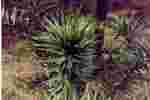
The growing tip on a meter-tall seedling. Image height 20 cm [C.J. Earle].
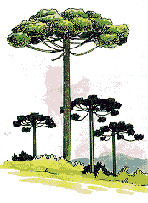
Pinheiros on the landscape (2).
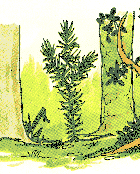
A seedling in the forest (2).
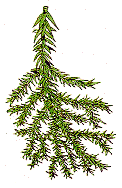
Branch with foliage (2).
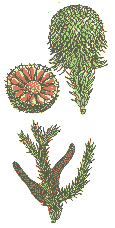
Seed (above) and pollen (below) cones (2).
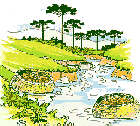
Baskets of nuts gathered by native people (2).
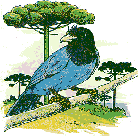
The blue gralha (Corvidae), state bird of Parana, is famous for his habit of planting pinheiro nuts (2). This sort of bird-tree symbiosis is common among many true pines (Pinus spp.), but I have not heard of it among other species of Araucaria.
Common Names
Portuguese: Pinheiro-do-Paraná (2); English: Parana pine or candelabra tree.Taxonomic notes
Syn: A. brasiliensis (1).Description
Tree, usually 25-35 m tall, with a straight trunk and horizontal branches, becoming flat-topped with age. Bark finely scaly, resinous, striated horizontally. Branchlets arranged in whorls of 4-8. Leaves sharply acute, needle-like, lanceolate, midrib visible, usually in pairs, dark green or glaucous, thick, 30-60 mm long by 6 mm wide, stomata above, keeled below, tending to be tufted at outer ends of branches. Leaves on fertile branchlets densely disposed spirally, much shorter, denser, with prominent stomata below. Male cone dense, shortly extending beyond the axil of the leaves, 10-18 cm long by 1.2-2.5 cm wide, scales imbricate. Female cone globular, 18-25 cm long by 13 cm wide, chestnut-brown, maturing in 2-3 years, wet weight ca. 1 kg, scales with a long recurved bract or umbo. Seeds light brown, 50 mm long by 8-20 mm wide, with narrow wings. Germination hypogeal. Cotyledons 2 (1, 2).Range
Brazil: 500-1800 m elevation in subtropical forests, primarily in the states of Paraná, Santa Catarina, Rio Grande Do Sul, and locally in São Paulo, Minas Gerais and Rio De Janeiro (2); also N Argentina and Paraguay at 500-2300 m (1).Big Tree
Grows to 50 m tall and 100 cm dbh (2).Oldest
Maximum ca. 500 years (2).Dendrochronology
Ethnobotany
Native Americans used to gather the cones and harvest the seeds for food. They would shoot the seeds down using blunted arrows, and bake the seeds before eating (2). Similar preparations attended use of bunya pine (A. bidwillii) by Australian Aboriginals. The pinheiro was, however, immediately recognized as a valuable timber tree when Europeans came to Brasil. Forest land grants began in 1511 and by the mid-18th century, the Araucaria forests were fast being cleared to provide timber for shipbuilding, construction and related uses. As in so much of the new world, though, the most destructive and extensive deforestation had to await the development of railroads and, later, large trucks. These enabled logging the bulk of the virgin pinheiro forests from the 1870's to the 1940's (2). Since that time, production has largely shifted to plantation forestry programs, for which purpose the species is planted not only in Brasil, but in subtropical environments across the globe.Observations
About 400.000 hectares (out of 7,500,000 presettlement hectares) of primitive forests of Araucaria still exist, the largest strongholds being in the region of General Carneiro and Bituruna (2).Remarks
The seed cones, containing on average 120 seeds (pinhões), are eaten by people; by other mammals including agoutis, rats, preás, ouriços, serelepes and monkeys; and by birds including gralhas, maitacas, parrots, and tirivas (2).Citations
(1) Silba 1986.(2) Pinheiro-do-Paraná. Website at http://www.pr.gov.br/celepar/seet/prtur/diversos/pinheiro/index.html, accessed 12-Apr-1999. Highly recommended.
See also:
L. Cardemil, E. Salas and M. Godoy. 1984. Comparative study of the karyotypes of South American species of Araucaria. Journal of Heredity 75(2):121-125. ABSTRACT: Root tips of both Araucaria araucana (Mol.) Koch and Araucaria angustifolia (Bert.) O. Ktze. were used as sources of mitotic chromosomes. Both species have 26 chromosomes as the diploid number, consisting of 13 pairs of homologues.
[Araucaria] [Araucariaceae] [home]
This page is from the Gymnosperm Database
URL: http://www.geocities.com/~earlecj/ar/ar/angustifolia.htm
Edited by Christopher J. Earle
E-mail:earlecj@earthlink.com
Last modified on 29-Jun-1999